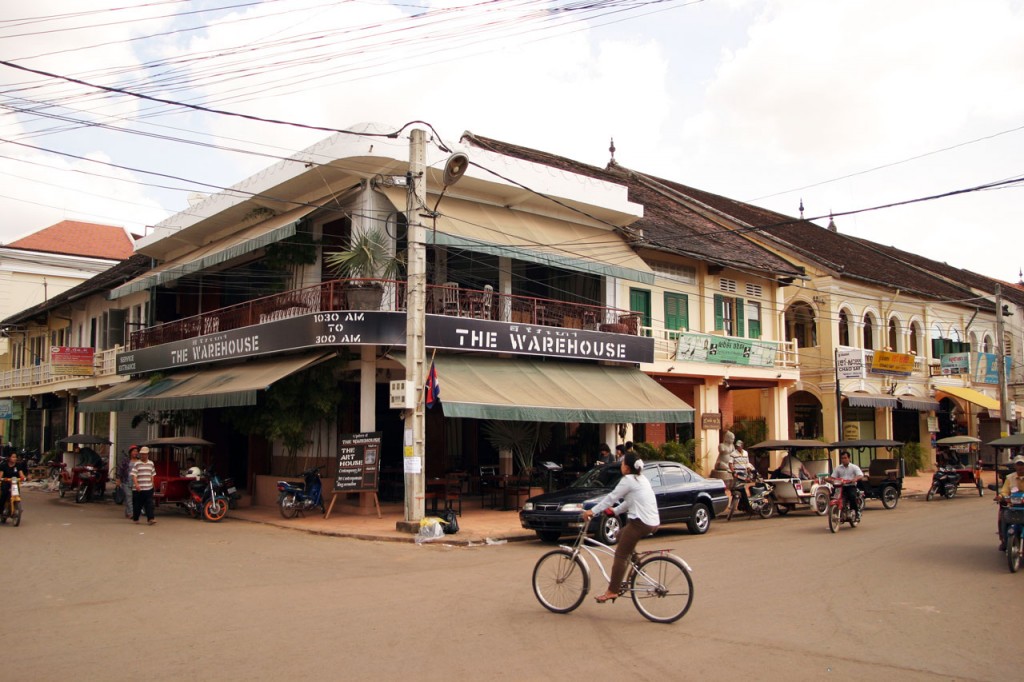The temples around Angkor are Southeast Asia’s greatest architectural gems, bar none, and the bustling capital of Phnom Penh has come a long way from a dangerous slum-scape to a chaotic but quite beautiful riverside city. Several remote temples that have lingered in deep forest, virtually forgotten for decades, have now also become accessible.

Downtown Siem Reap. Photo by Brian Jeffery Beggerly licensed Creative Commons Attribution.
In little more than a decade, Cambodia’s temple town has developed from a few blocks of crumbling colonial architecture into a bustling tourist mecca. Siem Reap, the jumping-off point for the main monuments of the Angkor Empire, keeps on growing, and while this can be a somewhat uneven process, visitors will find everything they need here—excellent accommodations for all budgets, a huge variety of food that includes local cuisine and Asian temptations as well as Western fare, and plenty of shopping opportunities, including attractive markets, with a few cultural attractions thrown into the lively mix. Siem Reap remains the country’s cleanest, safest, and best organized town, though it is the temples a few kilometers away that are the real attraction.
Temples, temples, and more temples. Several huge imperial capitals of the Khmer Empire flourished in the northwest of Cambodia between the 10th and 15th centuries and ruled Cambodia as well as large parts of today’s Thailand, Laos, and Vietnam. Today, only temple ruins—magnificent dreams in stone—remain, and the Angkor Archaeological Park, a UNESCO World Heritage Site, is not only a tourist magnet attracting two million visitors each year but also the spiritual and cultural heart of Cambodia.
Cambodia’s capital has come a long way in the last decade, from a dangerous backwater to a bustling, dynamic, and somewhat chaotic boomtown, and it has rediscovered some of its Old World charm in the process. Yes, the streets are pretty safe—if a little clogged with traffic—and hundreds of restaurants, bars, and clubs await visitors who can party around the clock against a background of colonial architecture and Cambodia’s newfound, if grossly uneven, economic regeneration. Add to that street markets, art galleries, and a few museums that are doing a good job at presenting both Cambodia’s Angkor era as well as its more recent catastrophic turmoil.
Several temple sites and attractive towns have emerged from a long slumber and now welcome visitors. Battambang, to the south of Siem Reap, is Cambodia’s second-largest city and offers a laid-back atmosphere, the best circus in Asia, excellent accommodations, great art galleries, and fantastic trips into the surrounding countryside. Remote temples such as Banteay Chhmar, Koh Ker, Sambor Prei Kuk, and Preah Vihear have become more accessible in recent years but are less crowded than the main sites, although this may change in coming years.
Cambodia’s climate is tropical year-round, except for the highlands in the northeast where it can get cool. The best time to visit is in the cool season, between October and early March. But that’s also the busiest time of year around the Angkor temples. During the hot season, from late March into June, much of the country turns into a furnace, although Khmer New Year in April is a special experience anywhere, especially around Angkor. Although it also often rains in November, the rainy season, from June to September, is a great time to explore the temple ruins, as there are fewer visitors. Keep in mind that some of the more remote temples could be inaccessible due to the terrible road conditions. In October, head to Phnom Penh for Bonn Om Tuk, the annual water festival with three-day boat races and a city bursting at its seams with visitors from the provinces.
Excerpted from the Second Edition of Moon Angkor Wat.